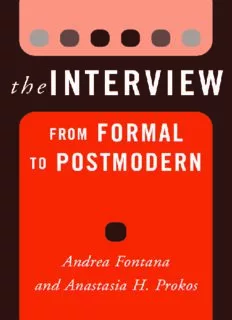Table Of ContentThe Interview
The Interview
From Formal to Postmodern
Andrea Fontana
and
Anastasia H. Prokos
Walnut Creek, California
Left Coast Press, Inc.
1630 North Main Street, #400
Walnut Creek, California 94596
http://www.LCoastPress.com
Copyright © 2007 by Left Coast Press, Inc.
All rights reserved. No part of this publication may be reproduced,
stored in a retrieval system, or transmitted in any form or by any means,
electronic, mechanical, photocopying, recording, or otherwise, with-
out the prior permission of the publisher.
Library of Congress Cataloging-In-Publication Data
Fontana, Andrea.
The interview : from formal to postmodern / Andrea Fontana and
Anastasia H. Prokos.
p. cm.
Includes bibliographical references (p. ) and index.
ISBN-13: 978-1-59874-108-7 (hardback : alk. paper)
ISBN-13: 978-1-59874-109-4 (pbk. : alk. paper)
1. Interviewing. 2. Interviews. I. Prokos, Anastasia H. II. Title.
BF637.I5F66 2007
158'.39—dc22
2007002475
07 08 09 5 4 3 2 1
Editorial Production: Last Word Editorial Services
Typesetting: ibid, northwest
Printed in the United States of America
The paper used in this publication meets the minimum require-
ments of American National Standard for Information Sciences—Per-
manence of Paper for Printed Library Materials, ANSI/NISO
Z39.48–1992.
Cover design by Piper F. Wallis
Contents
Preface.......................................................................7
1. Interviewing in Perspective................................9
The Interview Society .......................................11
The History of Interviewing..............................13
2. Structured Interviewing................................... 19
3. Group Interviewing ........................................ 29
4. Unstructured Interviewing ............................. 39
Accessing the Setting ........................................43
Understanding the Language and Culture
of the Respondents........................................43
Deciding How to Present Oneself .....................44
Locating an Informant ......................................44
Gaining Trust ....................................................45
Establishing Rapport .........................................46
Collecting Empirical Material............................47
5. Types of Unstructured Interviewing............... 49
Oral History ......................................................49
5
Creative Interviewing........................................51
Postmodern Interviewing..................................52
Grounded Theory and the Interview ................56
Gender and Interviewing ..................................59
6. Framing and Interpreting Interviews............. 69
Framing Interviews ...........................................69
Interpreting Interviews......................................72
7. Ethical Considerations.................................... 77
8. New Trends in Interviewing........................... 83
The Interview as a Negotiated
Accomplishment...........................................84
Empathetic Interviewing...................................88
The Problematics of New Approaches ..............94
9. Future Directions ............................................ 97
Formal Interviews .............................................97
Group Interviews ............................................101
Unstructured Interviews..................................102
Electronic Interviewing ...................................107
10. Conclusion .................................................. 111
Glossary........................................................................ 115
References .................................................................... 123
Index ............................................................................ 141
About the Authors........................................................ 147
Preface
Books on interviewing are not scarce, yet we felt that there
was a void. Currently available texts on interviewing by
and large cover only a portion of the various modes of
interviewing. Also, they tend to become “manuals,”
how-to books, teaching by the numbers. Books on formal
interviewing ignore unstructured interviewing as “non-
scientific,” while books on unstructured interviewing,
especially those leaning toward postmodern approaches,
vehemently attack more traditional modes of interview-
ing, but rarely do any of them point out the shortcomings
of their own mode of interviewing.
In this book we attempt to cover all the various
modes of interviewing, providing the general gist of the
various types, giving examples of how they may be used
and in what types of research, and pointing out the de-
ficiencies of each type without privileging any of them.
We begin with formal, traditional modes of interviewing,
move on to group and focused interviewing, and then look
7
8 Preface
at the numerous types of unstructured interviewing. We
discuss how interviews are framed and interpreted and
outline the ethical implications of interviewing. We present
new modes of interviewing and point to future trends in
interviewing.
We provide a comprehensive and up-to-date refer-
ence section to allow readers to delve more deeply into
any of the various modes that may be of particular inter-
est to them. The manuscript itself is written in a direct
manner, void of rhetoric. We have tried hard to stay on
course and be lucid, simple, and to the point. We hope
we have succeeded.
We wish to thank James Frey, who, with Fontana,
co-authored the original essay that provided the impetus
for the book. He graciously gave us permission to use his
material, since, being retired, he is now more interested
in golf than interviewing. We also wish to thank Sage
Publications, which allowed us to use the material from
the third edition of the essay (Andrea Fontana and James
H. Frey, “The Interview: From Neutral Stance to Political
Involvement,” in The Sage Handbook of Qualitative Research,
3rd Edition, edited by Norman K. Denzin and Yvonna S.
Lincoln, Thousand Oaks, CA: Sage). Jennifer Keene pro-
vided helpful comments and edits for the chapters on struc-
tured interviews and gender and interviewing, and we
are thankful for that as well. Finally, we wish to thank
our editors at Left Coast Press for their support and for
providing acute insights on the content of the manuscript.
Interviewing in Perspective 9
1
Interviewing in
Perspective
Asking questions and getting answers is a much harder
task than it may seem at first. The spoken or written word
always has a residue of ambiguity, no matter how care-
fully we word the questions and how carefully we report
or code the answers. Yet interviewing is one of the most
common and powerful ways in which we try to under-
stand our fellow humans. Interviewing includes a wide
variety of forms and a multiplicity of uses. The most common
form of interviewing involves individual, face-to-face verbal
interchange, but interviewing can also take the form of
face-to-face group interchange, mailed or self-administered
questionnaires, and telephone surveys. It can be struc-
tured, semistructured, or unstructured. Interviewing can
be used for marketing research, political opinion polling,
therapeutic reasons, or academic analysis. It can be used
for the purpose of measurement, or its intent can be to
better understand an individual or a group. An interview
9
Description:Used by everyone from survey researchers to oral historians, the interview may be the most basic and essential field method in the qualitative researcher’s toolkit. In this concise, student-friendly guide, Fontana and Prokos give a cogent introduction to the history, types, and methods of intervie

